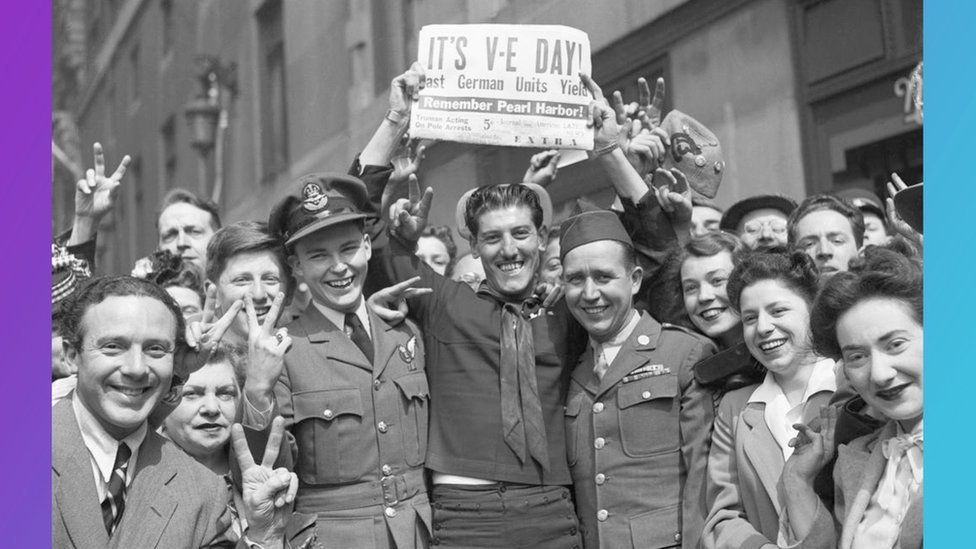VE Day: What is it, when is it and why do we remember?
- Published

VE Day - or 'Victory in Europe Day' - marks the day towards the end of World War Two (WW2) when fighting against Nazi Germany in Europe came to an end.
On 8 May 1945, Prime Minister Winston Churchill made an announcement on the radio at 3pm that the war in Europe had come to an end, following Germany's surrender the day before.
Read on to find out more about what happened on VE Day and how World War Two came to an end.
Learn more about World War II
Colonel Tom Moore shares his VE Day memories
If you can't see this video, click here
How was VE Day celebrated?
By the beginning of 1945, the German army had been weakened and defeat looked likely.
Tuesday 8 May, 1945, was an emotional day that millions of people had been waiting for.
Many people were extremely happy that the fighting had stopped and there were big celebrations and street parties.
Huge crowds - with lots of people dressed in red, white and blue - gathered outside Buckingham Palace in London.
They cheered as King George VI and his family, including Princess Elizabeth (the current queen) and Princess Margaret, came out onto the balcony to greet everybody.
Princess Elizabeth and her sister were allowed to leave the palace and celebrate with crowds outside, although they had to do it secretly.
The future Queen described it as "one of the most memorable nights of my life".
Many people also attended church services to thank God for the victory.
London's St Paul's Cathedral held 10 services, which were attended by thousands of people.
But VE Day was also a moment of great sadness and reflection, as millions of people had lost their lives or loved ones in the conflict.
Many had to continue fighting in other battles and lots of people were being kept as prisoners of war abroad.
What does VE Day mean to my grandfather?
If you can't see this video, click here
Was VE Day the end of World War Two?
Even though VE Day marked victory for Europe over Germany, it did not mark the end of World War Two.
In his VE Day announcement, Winston Churchill said: "We may allow ourselves a brief period of rejoicing, but let us not forget for a moment the toil and efforts that lie ahead."
Even after 8 May, many soldiers, sailors and pilots were sent to the east to fight against the Japanese, who had not yet surrendered.
On 15 August 1945, the allies had officially defeated Japan. This date is known as VJ Day.
World War Two was finally over.
Did you know?
2 September is also known as VJ Day, as this is the day in 1945 when Japanese leaders signed a document to officially surrender.
What happened after World War Two?
While the war was over, it was not the end of hardship.
Millions of people had lost loved ones and their lives had been turned upside down by the fighting.
The nation had to rebuild as the war had been so expensive. Clothing and food rationing remained in place.
By the end of WW2, the foundations had also been laid for something called the Cold War, which would last until December 1991.
- Published27 January 2013
- Published26 January 2022
- Published29 June 2016
